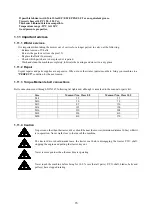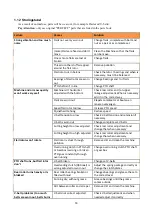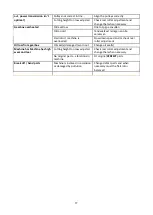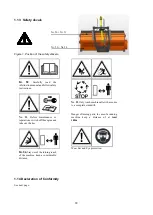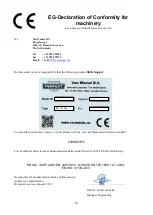
7
MAIN PRECAUTION
Every time before you take the machine in service you must check the machine and the tractor
on all safety precautions.
1.2 Safety and accident prevention
1.2.1 Safety and accident prevention
1.
The warning decals on the machine give you important assignments how to use the machine (see also chapter
1.10).
Check presence of all decals, and replace them if necessary.
2.
During night road-transport and also when weather conditions make it necessary the tractor and machine must be
provided with correct illumination.
3.
Take care of all precautions written in this manual and prescribe by the law.
4.
Before taking the machine in service you must make yourself familiar with all functions and parts of the machine.
5.
Because of spinning parts (P.T.O. shaft, pulleys and V-belts) it is recommended strongly that the tractor driver wear
tight-fitting cloths.
6.
To limit fire risk it is recommended strongly to clean the machine at regular times, also underneath the protection
covers.
7.
The machine must be coupled to the tractor as written in this manual
8.
When the machine is coupled to the tractor, the tractor must be secured against rolling by the hand brake. During
coupling it is anybody forbidden to stay in between tractor and the flail chopper.
9.
During road transportation the machine must always be coupled central.
10.
Tractor front-counter-weights must be placed at the prescribed places.
11.
Pay attention to the maximum allowed axe-load, especial by front mounted machines.
12.
It is forbidden to transport people and/or animals on the machine during cutting-work and/or road-transport.
13.
Before you put the machine in service you must check if nobody,
also children and animals
, stays nearby the
machine. Be aware you have an unobstructed view.
14.
During road-transport and work it is forbidden to the tractor driver to leave the cabin.
15.
Adapt the speed to the circumstances. Be careful when working at hill -sides and at sharp turns.
16.
The drive- and brake-demeanour of the tractor will be influenced by the coupled machine and counter-weights. Be
careful, keep sufficient brake-distance.
17.
Take care of the outstanding machine in turns.
18.
Do not take the machine in service before you have checked the condition of all protection elements. Replace them
if necessary.
19.
Before the tractor driver leaves the cabin he has
always
to disengage the tractor P.T.O. shaft, to pull the hand brake,
to shut-off the motor and to pull the tractor key out.
20.
Before using the machine, check this for oil leaks. This can affect the operation of the machine and cause damage
the machine and / or environment.
1.2.2 P.T.O. driven machine
1.
Only use the P.T.O. shaft that is supplied with the machine it-selves (see also 1.3.3).
2.
Check the protection guards of tractor, machine and P.T.O. shaft.
3.
Check the overlap of the protection guards, this should be at least 50 mm. Also if using a P.T.O. shaft with
overrunning clutch.
4.
Check the overlap of work- and protection-tubes, in all work- and transport-positions of the machine.
5.
(Dis-)connecting of the P.T.O. shaft is only permitted when the tractor P.T.O. shaft is disengaged, the motor is shut-
off and the tractor key is pulled out.
6.
Be sure that the P.T.O. shaft is coupled correctly. The sliding pins should fit the corresponding slots and they should
be returned in out-standing position.
7.
Secure the protection guard against spinning by fixing the chains.
8.
Before you engage the tractor P.T.O. you must check if the chosen tractor P.T.O. speed corresponds with the
prescribed speed of the machine. The machine speed is indicated on a decal on the gearbox-cover.
9.
Before you engage the tractor P.T.O. you must check if nobody, also children and animals, is nearby the machine.
10.
Never engage the tractor P.T.O. when the tractor motor is shut-off.
11.
Disengage the tractor P.T.O. when the angle of the P.T.O. shaft becomes too big.
12.
Be aware that the machine will still run for a while after you have disengaged the tractor P.T.O. Do not come close
to the machine while it is still running.
Only when the machine completely stands still, it is allowed to start adjustment-, cleaning-, service- and/or repair-

















